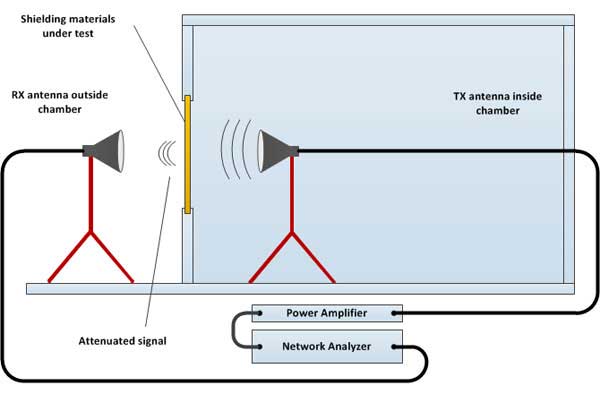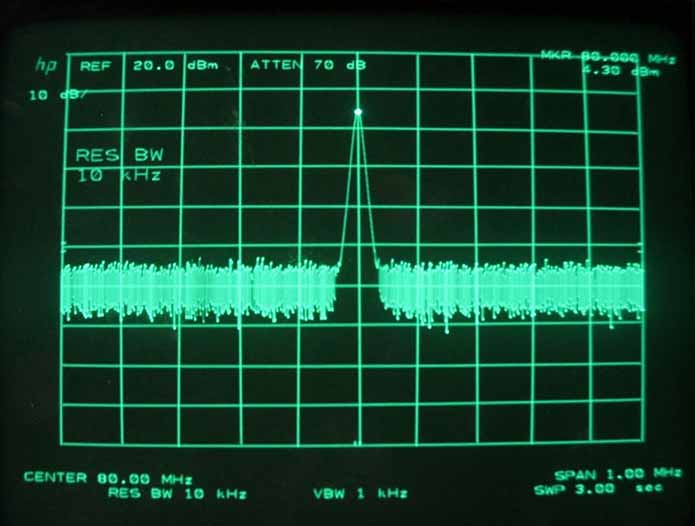IEC-50147-1 - MEASURING THE EFFECTIVENESS OF ELECTROMAGNETIC SHIELDING ENCLOSURES
This standard
IEC-50147-1 applies to measurements of shielding attenuation of shielded enclosures (chambers, rooms) in the frequency range 9 kHz - 40 GHz. The object of this standard is to establish a common measurement procedure for validating the shielding effectiveness of a shielded enclosure.
Shield Attenuation Measurement
The measurement is normally carried out with all the shielding components in place and, in the case of filters, with all wires and cables connected.
NOTE: The procedure is derived from NSA 65-6; National Security Agency Specification for R.F. Shielded Enclosures for Communication Equipment.
Test equipment
The following types of equipment shall be used in performing that shield attenuation test, depending on the frequency range given in the specification of the enclosures. The measurement equipment shall have sufficient dynamic range to enable the test to be performed:
- CW signal sources covering 9 kHz to 40 GHz with adequate frequency stability. If unavailable in the microwave region (1-40 GHz), pulsed sources may be substituted.
NOTE: The starting frequency for shield attenuation measurements may be 10 kHz if the measurement equipment offers no other alternative.
- Loop antennas for magnetic field measurements
-
Tunable of broadband dipoles, monopoles with ground planes for electric field and plane wave measurements, and horn antennas for plane waves at microwave frequencies.
-
Probes for joint leakage tests.
-
Receivers with adequate sensitivity.
Acceptance tests
Measurements shall be taken at several positions around the enclosure as given in the specification of the enclosure. In general, these measurements are made before absorber installation.
If the ambient noise level is low enough, all tests should be run with the receiver outside and the transmitter inside the enclosure.
Leakage test
Prior to acceptance tests leakage tests should be made all around the door frame, through accessible joints, around the filters and all around the air ducts. In addition, the magnitude and location of the maximum signal level emanating from the enclosure should be found by moving the antennas to at least four locations, preferably on different walls.
Electric and magnetic field measurements
Electric and magnetic field attenuation tests (reference measurements) shall be made with the antennas located directly opposite each other and separated by a specific distance plus the wall thickness.
Magnetic fields shall be measured with the loops parallel to a wall panel directly opposite each other.
Reccomend test frequencies for magnetic fields are 10 kHz, 100 kHz, 1 MHz, 10 MHz and 30 MHz, and 10 MHz and 30 MHz for electric field.
Plane wave measurements
Measurements shall be taken at the frequencies 100 MHz, 400 MHz, 1 GHz, 10 GHz and 40 GHz at least, depending on the frequency range given in the specification of the enclosure.
Emctest Technologies is a laboratory that performs shielding effectiveness tests on site, directly
to the customer, in Italy and in Europe, or at its headquarters in Rimini - Italy.
We perform shielding effectiveness tests for several sectors:
- private
- industrial
- medical
- nautical
- aviation
- military
- scientifical
Typical shielding effectiveness measurement frequencies are: 10 kHz, 100 kHz, 500 kHz, 1 MHz, 10 MHz, 30 MHz, 100 MHz, 433 MHz, 700 MHz, 800 MHz, 900 MHz, 1 GHz, 1.5 GHz, 2.4 GHz, 3 GHz, 5 GHz, 5,8 GHz, 6 GHz, 10 GHz, 17 GHz, 18 GHz, 24 GHz (Industrial, Scientific, and Medical - ISM - band), 26.5 GHz, 30 GHz, 35 GHz, 40 GHz, 50 GHz, 60 GHz (Wireless communication and radar applications), 75 GHz, 77 GHz (Automotive radar systems), 94 GHz, 100 GHz, 110 GHz.
Our lab test can perform shielding effectiveness measurements up to 110 GHz.
Read more about it going back to the home page. Or if you are looking for a lab in order to test your product contact us via email or by phone simply clicking here.
Measurements are made according to customer specifications or in accordance with the main standards as below:





